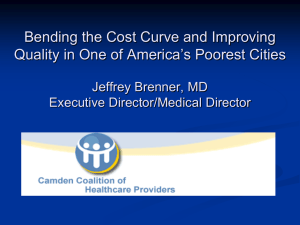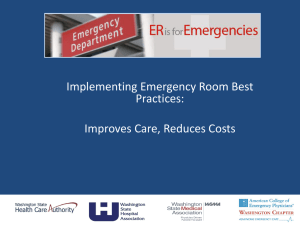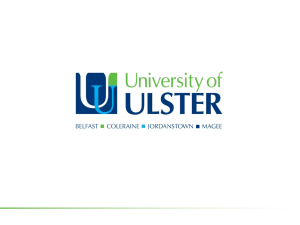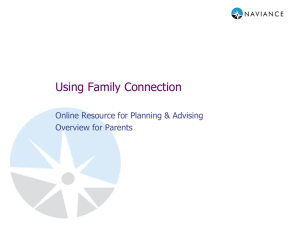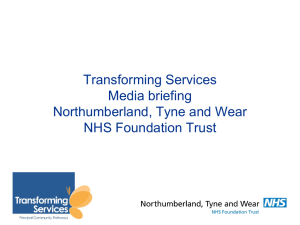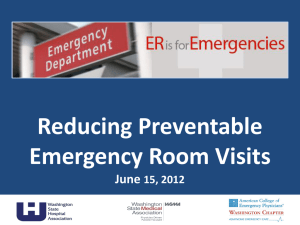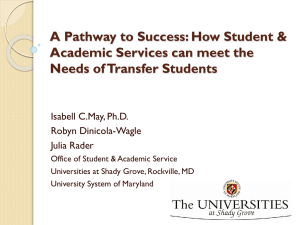E2 - Collaborative Family Healthcare Association
advertisement
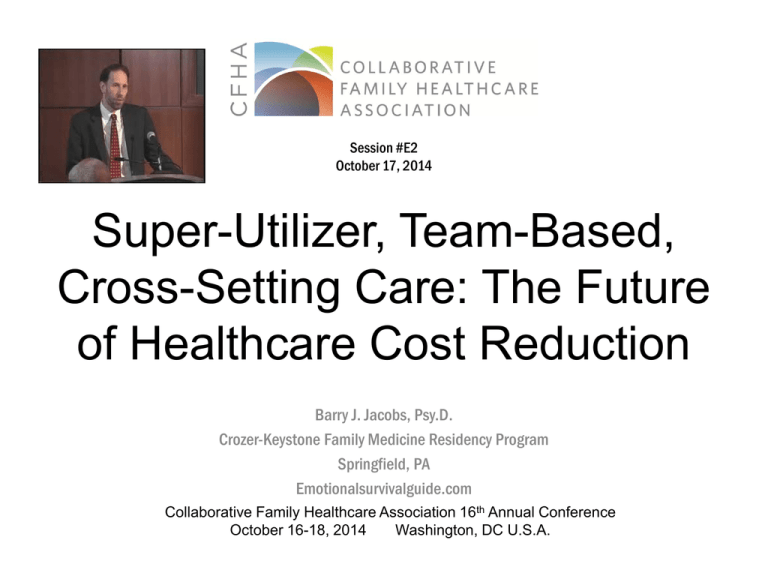
Session #E2 October 17, 2014 Super-Utilizer, Team-Based, Cross-Setting Care: The Future of Healthcare Cost Reduction Barry J. Jacobs, Psy.D. Crozer-Keystone Family Medicine Residency Program Springfield, PA Emotionalsurvivalguide.com Collaborative Family Healthcare Association 16th Annual Conference October 16-18, 2014 Washington, DC U.S.A. Faculty Disclosure Please include ONE of the following statements: • I currently have the following relevant financial relationships during the past 12 months: – 20% of my salary is currently covered by a proof of concept study grant from Independence Blue Cross/Blue Shield Learning Objectives At the conclusion of this session, the participant will be able to: • Identify the key components of the superutilizer approach for reducing healthcare costs • Describe the integrated team composition and processes of super-utilizer programs • Understand the implications of superutilizer programs for developing tiered care for chronically ill patients Bibliography / Reference 1) Gawande, A (2011). The hot-spotters. The New Yorker, January 24 downloaded 9-20-14: http://www.newyorker.com/magazine/2011/01/24/the-hot-spotters 2) “Top 8 Best Practices,” (2014), publication of the Camden Coalition of Healthcare Providers, 3) “Super Utilizer Summit—Common Themes from Innovative Complex Care Management Programs” (October 2013), downloaded from Robert Wood Johnson website on 9-20-14: http://www.rwjf.org/content/dam/farm/reports/reports/2013/rwjf40799 0 4) Coburn KD et al (2012). Effects of a Community-Based Nursing Intervention on Mortality in Chronically Ill Older Adults: A Randomized Control Trial, PLoS Medicine, 9(7), 1-14 5) Hoefer, D (2010) Transitions Frailty, video of presentation from the Family Medicine Education Consortium 2010 conference downloaded 9-20-14: http://vimeo.com/40317051 Learning Assessment • A learning assessment is required for CE credit. • A question and answer period will be conducted at the end of this presentation. Today’s Talk • Dr. Jeff Brenner’s story • Who are super-utilizers and why do they matter? • Components of SU interventions • The Crozer-Keystone SU programs with 3 case illustrations • Lessons learned “The Hot Spotters”—1/24/11 Who is Jeff Brenner, MD? • Closed solo family medicine practice in Camden, NJ • Looked at city’s healthcare data • Founded Camden Coalition of Healthcare Providers 1% 5% 10% $90,061 22% $40,682 50% $26,767 50% 65% $7,978 97% U.S. Population Health Expenditures Distribution of Health Care Expenditures for the U.S. Population, According to Magnitude of Expenditure, 2009 The sickest 10% of patients account for 65% of the health care expenses. Dollar amounts are annual mean expenditures per patient. Data from the 2009 Medical Expenditure Panel Survey, adapted from the Commonwealth Fund. Anticipated Federal Debt Characteristics of High-Utilizers • Most are insured, 60% public insurance • Only 15% uninsured • Over 80% have identifiable PCPs • More utilization of health services in general • Diagnoses vary greatly • Ages 25-44 and over 65 Usage Patterns • ED high utilizers = >3x per year • Often patients with trauma histories, personality disorders, drug problems • Inpatient high utilizers = >2 inpatient admissions within a 6-month period • Often social issues (e.g., housing, transportation, chaotic families) Components of SU Interventions • A cross between intensive biopsychosocial care and community organizing: • Data mining (sometimes across health systems and agencies) to create SU list • Creation of collaborative multi-disciplinary teams: physicians, nurses, case managers, pharmacists, social workers, psychotherapists, volunteers • Assessment procedures and outcome measures • Relationship-building with other healthcare and social service providers to improve care transitions Interventions (cont.) • Strong emphasis on addressing social determinants of health: • Housing, transportation, food • Home visits essential • Focus on trauma and addictions • Medical visit accompaniment • Use of community health workers • Breaking down silos between healthcare and social service agencies Care Continuum Model Hospital Admission s Data • • • Inclusion Triage Multidisciplinary care management outreach Patients with history of ED visits/hospital admissions and readmissions (4 admits w/in 6 mos.); social complexities Average 6-8 month engagement Medical Home CCHP Outreach Care Coordination High Risk Health Coaching Intermediate Risk Data driven care mgt. Patient Engagement • • • Nurse driven care transition Patients with history of ED visits/hospital admissions and readmissions (2+ admits w/in 6 mos.); socially stable Average 6-8 week engagement Results The Camden Study-An ED Alternative • 5 year study of 380,000 visits at 3 EDs • 1% of patients 40,000 visits, $46 million cost • Top 35 utilizers generated $1.2 million in charges each month • After one year of SU care, costs dropped to $531,000 South Central PA High Utilizer Collaborative South Central PA High Utilizer Collaborative 18 SOUTH CENTRAL PA WHITE PAPER 6/14 • With 138 combined patients enrolled in SU programs, inpatient admissions decreased 34% • ED utilization increased Crozer-Keystone Health System CKHN Inpatient and ED Stats: 2012 IP: Inpatient Visits > 3 / year = 457 Readmission > 1 = 308 (67%) ED: Emergency Room > 4 / year = 889 1275 Individual Patients Combined IP & ED TOTAL LOSS (Paid-Costs) = -$3,136,933 Center for Family Health • One of two training sites for CrozerKeystone Family Medicine Residency • NCQA accredited PCMH since 2008 • SU program as overlay on PCMH care • Titrate up, graduate (8 months), titrate down SD—Inpatient Super-Utilizer • 64 yo retired electrician living with his wife • 13 admissions for CHF in 2010-11 (over 12 month period) Post-enrollment Charges = $11,686 ; Receipts= $0. Inpatient: 0; ED visits:3 Length of Stay 1 year pre-enrollment Charges= $520,000; Receipts= $90,000; Inpatient:12; ED visits:7 • IP Admit • ED Visit CB—ER Super-Utilizer • 60 yo on disability for chronic pain due to fibromyalgia; also remote history of mild CVA • Worked as welfare case manager for over 30 years • Pastor/pastoral counselor CB (cont.) • Between 1996-2012, had 102 ER visits • Included 21 visits in both 2008 and 2009 • Had 112 CT scans, including 71 head CTs CB (cont.) • Gradually decreasing her habit of going to ER through increasing her awareness of mindbody connections, decreasing her anxiety, reducing family support for utilization • 2012: 8 • 2013: 5 • 2014: 1 (thus far) Our Team Patient Selection Identification • Inpatient Census • PCP Referral • Insurance High-Risk Lists • CKHS Financial Reports • (Note 6-12 month lag time) Selection • Inclusion • Two or more inpatient admissions in past 6 months • Exclusion • Mental Health Only • Oncology • Surgery • Pregnancy Screening & Assessment Visit Introduction • Team Members • Goals of program • Care Agreement • Record Release Engagement • Willingness to answer phone calls • Allow home visit • # of no shows for PCP in last year • # of previous PCPs in last year • Goal alignment Activation Readiness to Change • URICA Tool • Patient Activation Measurement (PAM) Clinical Process Visit 1 Visit 2 • Assessments • Psychology • Social Work • Pharmacy • SU Team Leaders • Review Goals • Review Care Plan HUDDLE Communicate with PCP Initial Note in EMR Scan RR and CA to EMR Results (11 patients) • • • • • • • • ER visits per patient per month: Before: 0.207 During: 0.16 OBS visits per patient per month: Before: 0.025 During: 0.147 Inpatient visits per patient per month: Before: 0.323 During: 0.046 Inpatient LOS per patient per month: Before: 1.096 During 0.16 IBC Medicare Advantage SU Program • Crozer-Keystone was approached by Independence Blue Cross in spring of 2013 to create a 1-year- proof of concept, superutilizer intervention for IBC’s Medicare Advantage patients within the CrozerKeystone Health System • Brenner excludes patients over age 80 • We drew on works of Ken Coburn, Dave Moen and Dan Hoefer • Coburn taught us power of home-based nursing intervention • Moen taught us power of home-based physician care • Hoefer taught us cost savings and increased life span with widespread palliative care Our Process • Analyzed IBC and CK utilization data • Chose 13 patients on basis of utilization, cost to IBC, losses to CK • Reached out to primary care physicians • Nurse case manager engages patients, conducts assessments and weekly visits • Uses multidisciplinary team as advisors during weekly Huddle • Includes family medicine fellows/residents; psychology, social work, pharmacy students • CO, 88 year old widow who lives in a multigenerational home. • Co-morbidities include: DM, CHF, HTN, CAD, Obesity, Peripheral Neuropathy & edema • Chaotic home environment • Patient having increased episodes of confusion Baseline utilization x 6 mos for CO 8 7 6 5 INPT LOS 4 OBS ER 3 Engagement 2 1 0 9/4/13 11/4/13 1/4/14 3/4/14 10/4/13 – Admitted for bilateral lower extremities cellulitis 11/20/13 – ER for Edema 11/24/13 – OBS for arm cellulitis 1/7/14 - Admitted pneumonia and CHF 2/5/14 – Admitted for change in mental status/Anemia/UTI Enrolled in Crozer Connections to Health Team program 2/12/14 5/4/14 Deep Dive • Social milieu/uncoordinated care – Family refused to have homecare RN visits posthospitalization – Our team has great concerns about caregiver burden and capacity, but the family didn’t want increased support services at this point • Possible dementia versus delirium – Family concerned about increasing confusion CO’S Outcomes Thus Far • Patient now sleeps upstairs with legs up— decreased cellulitis • Blood sugars better controlled • No hospitalizations from 1/14-8/14 • 8/14: hospitalization for possible CVA; turned out to be Bell’s palsy • Family has accepted home nursing for wound care • Primary caregiver still contending with burnout Lessons Learned • Interdisciplinary team-based, cross-setting care has resulted in mostly great success—but also spectacular failures • Patient engagement still key—takes 2 months • Graduating patient from SU care and return to PCMH takes careful planning or risks reversion to previous level of utilization • SU is essential overlay for PCMH to address most complex, expensive patients Session Evaluation Please complete and return the evaluation form to the classroom monitor before leaving this session. Thank you!
